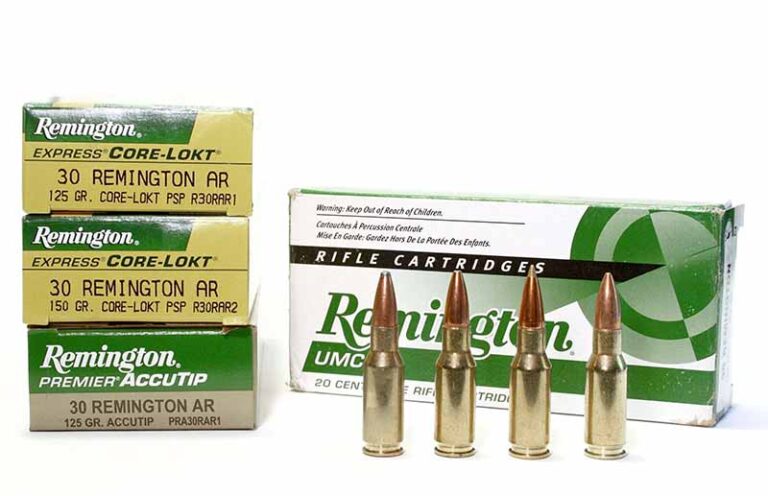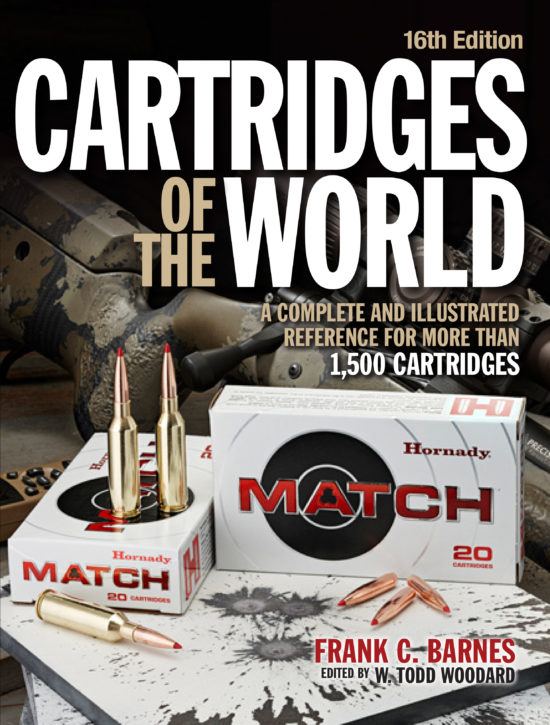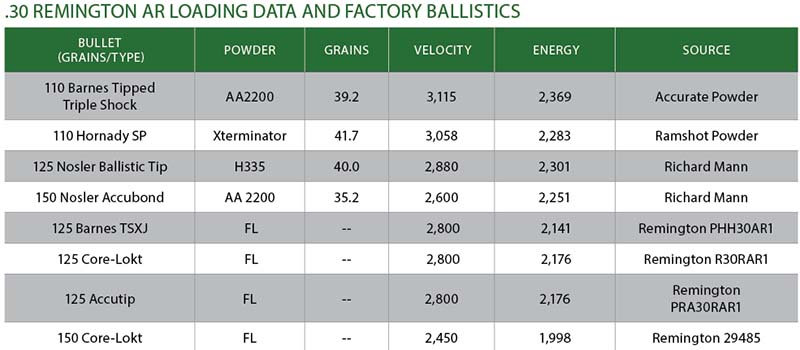
A quick look at .30 Remington AR, a cartridge designed for big-game hunting with an AR-15.
The .30 Remington AR was designed by Remington as a big-game cartridge specifically for the company’s R-15 rifle. It was introduced in 2009. Remington engineers started with the .450 Bushmaster case and went from there. A pointed .30-caliber bullet of reasonable weight is longer than a blunt-nosed .45-caliber bullet, so, to keep overall cartridge length compatible with the standard AR-15 magazine, the case was shortened to 1.525 inches from the original 1.7 inches of the Bushmaster design.
Back at its base, the .30 AR case starts with a diameter of 0.500 inch, and from there it tapers to 0.488 inch at the juncture of the body and shoulder. Neck diameter is 0.341 inch, and the case has a shoulder angle of 25 degrees.
The AR-15 rifle in .450 Bushmaster utilizes the standard .223 Remington bolt, modified by increasing its bolt face diameter to a nominal 0.473 inch (same as the .308 Winchester). When this is done, the counterbore wall, or shroud of the bolt, becomes rather thin. This is considered a safe modification because the cartridge operates at a maximum chamber pressure level of 38,000 psi (same as the .30-30 Winchester).

But, because the .30 AR is loaded to 55,000 psi, Remington opted for additional case rim support. This was accomplished by modifying the larger-diameter AR-10 bolt to fit the AR-15 upper. The face of that bolt is commonly sized for the 0.473-inch rim diameter of the .308 Winchester, but Remington went one step further by opening it up a bit and increasing the rim diameter of the .30 AR case to 0.492 inch.
By the time the job was done, the only thing the .30 AR case had in common with the .450 Bushmaster case was a base diameter of 0.500 inch. Remington went with a case rim diameter larger than that for the .450 Bushmaster to prevent a bolt built for that cartridge from being used in an R-15 upper with a .30 AR barrel.
General Comments
With a length of 0.305 inch, the neck of the .30 Remington AR is capable of exerting plenty of tension on the bullet, a good thing to have on a cartridge designed to survive the rather violent trip it must take from the magazine to the chamber of an auto-loading rifle. The short, fat case of rebated rim design has a gross capacity of 44 grains, about 10 grains less than in the .308 Winchester case, or approximately the same as in the .30-30 Winchester case.

But because the .30 AR is loaded to higher chamber pressures than the .30-30 Win., it exceeds the maximum velocity of that cartridge. When the 125-grain Core-Lokt factory load is zeroed 3 inches high at 100 yards, it will strike about 2 inches above point of aim at 200 yards and approximately 7 inches low at 300, where it’s still packing upward of 1,000 ft-lb of energy. The .30 AR comes close to duplicating the performance of the .300 Savage when both are loaded with a 125- or 150-grain bullet.
The allure of this cartridge is that it turns the AR-15 platform into a true big-game rifle capable of terminal performance identical to that of the .300 Savage with bullets weighing 150 grains or less. It’s suitable for deer, black bear and similarly sized game out to around 300 yards. Also, wildcatters have necked the .30 Remington AR case up and down, further increasing the versatility of the AR-15 platform.
Editor's Note: This article is an excerpt of Gun Digest's Cartridge's Of The World.
Raise Your Ammo IQ:
- Beyond The 6.5 Creedmoor: The Other 6.5 Cartridges
- The Lonesome Story Of The Long-Lost 8mm
- Why The .300 H&H Magnum Still Endures
- .350 Legend Vs .450 Bushmaster: Does One Win Out For Hunting?

Next Step: Get your FREE Printable Target Pack
Enhance your shooting precision with our 62 MOA Targets, perfect for rifles and handguns. Crafted in collaboration with Storm Tactical for accuracy and versatility.
Subscribe to the Gun Digest email newsletter and get your downloadable target pack sent straight to your inbox. Stay updated with the latest firearms info in the industry.

![Best Concealed Carry Guns In 2025 [Field Tested] Wilson Combat EDC X9S 1](https://gundigest.com/wp-content/uploads/Wilson-Combat-EDC-X9S-1-324x160.jpg)


![Best 9mm Carbine: Affordable PCCs [Tested] Ruger Carbine Shooting](https://gundigest.com/wp-content/uploads/Ruger-Carbine-Shooting-100x70.jpg)
![Best AR-15: Top Options Available Today [Field Tested] Harrington and Richardson PSA XM177E2 feature](https://gundigest.com/wp-content/uploads/Harrington-and-Richardson-PSA-XM177E2-feature-100x70.jpg)
